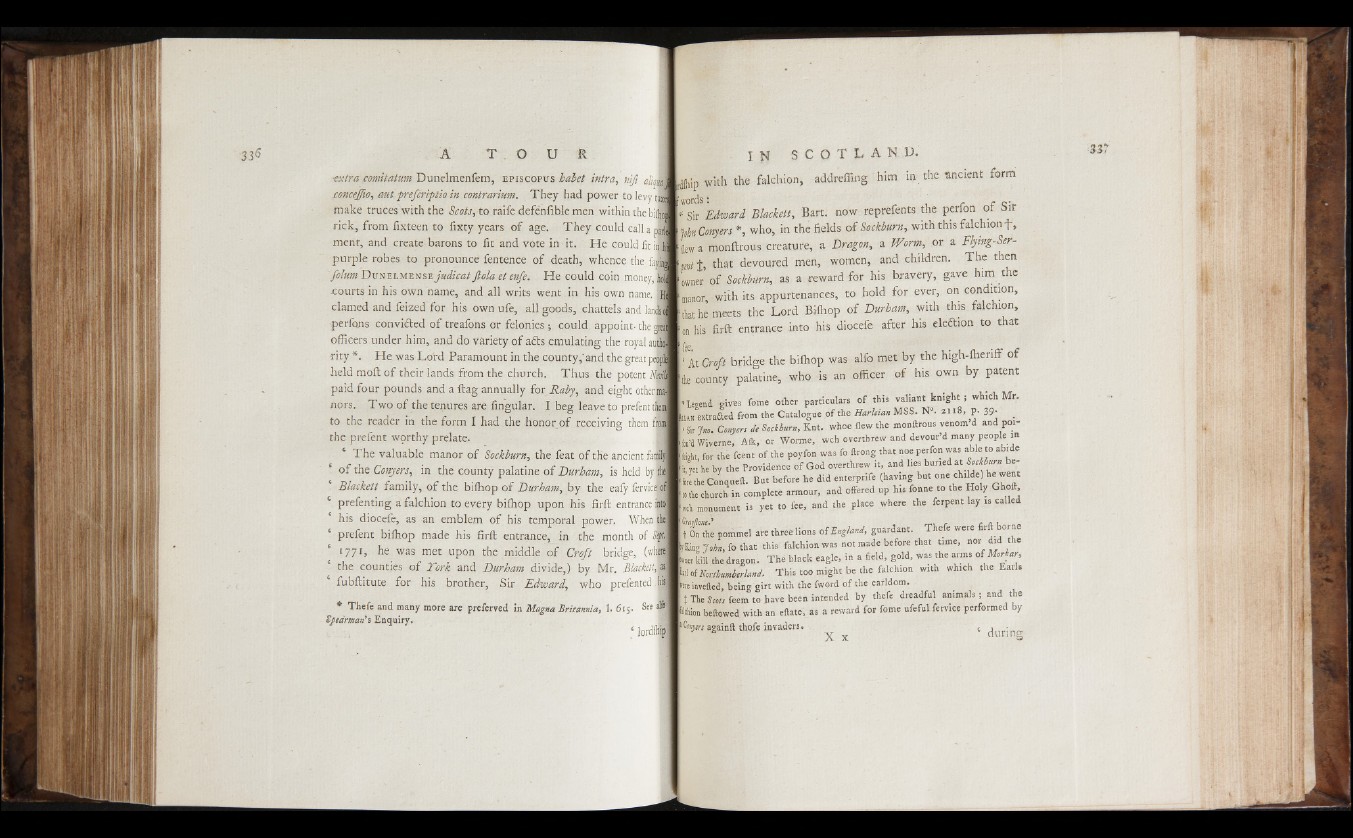
I N S C O T L A N D .
him in the ancient form
A T O U R
■extra comitatum Dunelmenfem, e p i s c o p u s habet intra, nifi alicA
concefjio, out. prefcriptio in contrarium. They had power to levy taxi
make truces with the Scots, to raife defenfible men within thebiM
rick, from fixteen to fixty years of age. They could call a J
ment, and create barons to fit and vote in ■ it. He could lit ¡fl
purple robes to pronounce fentence of death, whence the fafl
folum D u n e lm e n s e judicat fiola etenfe. He could coin money,*
courts in his own name, and all writs went in his own name. flj
clamed and feized for his own ufe, all goods, chattels and lamT
perfcms convicted of treafons or felonies ; could appoint- the gitj
officers under him, and do variety of a£ls emulating the royal autbl
rity *. He was Lo'rd Paramount in the county,'and the great peo|
held moil of their lands from the church. Thus the potent Ntm
paid four pounds and a flag annually for Raby, and eight otherB
nors. Two of the tenures are fingular. I beg leave to prefent thejj
to the reader in the form I had the honor of receiving them f f l
the prefent wprthy prelate. I ,W4 Wlverne,
‘ The valuable manor of Sockburn, the feat of the ancient fan»! Hit, for the fcent o f the poyfon was fo ftrong that noe per on was a e o a i
e c , . ^ 6 t. . ^ . v. - r i t . and lies buried at ¡¡ockburn Deor
the Conyers, in the county palatine of Durham, is held by; the
- Blackett family, of the bilhop of Durham, by the eafy iervice I
* prefenting a falchion to every bilhop upon his firil entrance intij
his diocefe, as an emblem of his temporal power. When the]
‘ prefent bilhop made his firil entrance, in the month of I
‘ 1771, he was met upon the middle of Croft bridge, (wheii
the counties of York and Durham divide,) by Mr. Blackett, as]
| fubilitute for his brother, Sir Edward, who prefented^
* Thefe and many more are preferyed in Magna Britannia, 1. 615. See a®
Spearman's Enquiry.
‘ lordllffl
Iggj with the falchion, addreffing
[‘‘'sir Edward Blackett, Bart, now reprefents the perfon of Sir
P | Conyers *, who, in the fields of Sockburn, with this falchion t ,
|w a monilrous creature, a Dragon, a Worm, or a Flymg-Ser-
mt%, that devoured men, women, and children. The then
owner of Sockburn, as a reward for his bravery, gave him the
manor, with its appurtenances, to hold for ever on condition,
¡that he meets the Lord Bilhop of Durham, with this falchion,
on His firil entrance -into his diocefe after his eleihon to that
‘ At Croft bridge the biihop was alfo met by the high-iheriff of
the county palatine, who is an officer of his own by patent
I B g ivES feme other particulars o f this valiant k n ig h t ; which M r.
I «¡traded from the Catalogue o f the Harltian MSS. N°. 2 n 8, p. 39. |
Sir 7no. Comm do Sockburn, K n t. whoe flew the monilrous venom d and pois
'd Wiverne, A ik ,'o r Worme, wch overthrew and devour’d many people in
for the fcent o f the poyfon was fo ftrong that noe perfon was able to abide
|yet he by the Providence o f God overthrew it, and lies buried f b e -
fore the Conqueft. But before he did enterprife (having but one childe he went
ito the church in complete armour, and offered up his fonne to the Holy Ghoft
jjri monument is y et to fee, and the place where the ferpent la y is called
W i m pommel are three lions o f England, guardant. Th e fe were firil borne
I) Ring John, fo that this f a l c h i o n w a s not made before that time, nor did the
i - kill the dragon. T h e black eagle, in a field, gold, was the arms o f Morkar,
Sarlof Northumberland. T h i s too might be the falchion with which the Earls
>«e invefted, being girt with the fword o f the earldom. 1 The Scots feem to have been intended by thefe dreadful animals ; and the
taion bellowed with an eflate, as a reward for fome ufeful fervice performed by
Craye-j againft thofe invaders. , , • X x aurina